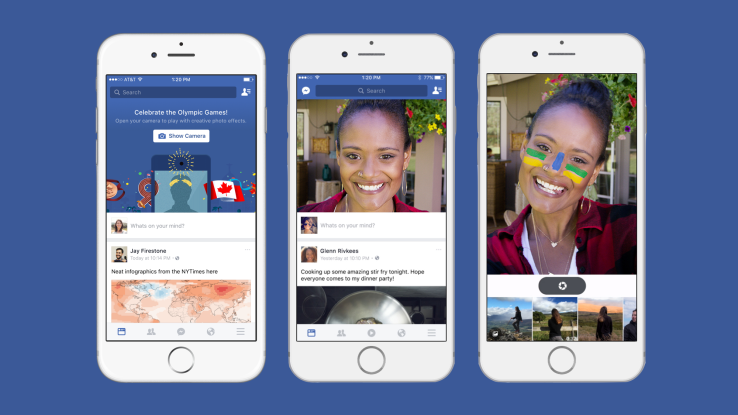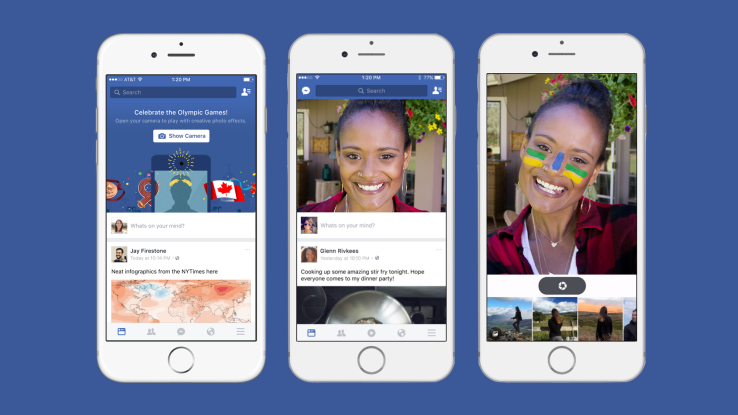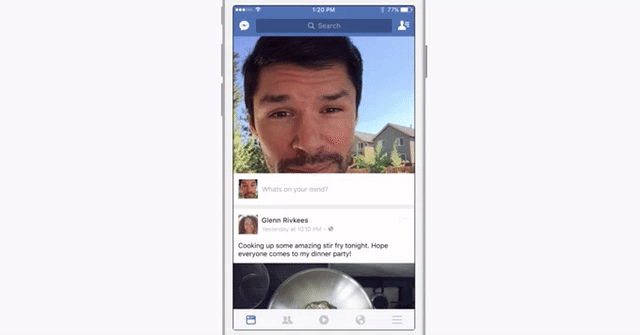

Snapchat opens to the camera by default to spur content creation, and now Facebook is trying the same starting with an Olympics-themed test in Brazil and Canada. Instead of just the “What are you doing?” text status update prompt, users will see an open camera window as Facebook executes on Mark Zuckerberg’s promise to put “video at the heart of all of our apps.”
The new feature also sports the first official integration of Facebook’s acquisition MSQRD’s animated selfie filters, which are similar to Snapchat’s selfie Lenses. Using MSQRD’s object recognition tech, users can swipe to apply different Olympics face paint like Brazilian flags and “Go Canada!” that match the contours of their face. People can also add static graphic overlay filters like “Team Canada”, similar to Snapchat’s geofilters, to photos and videos they shoot or upload.
Here’s a demo of the features:
The test that I call the “camerafeed” will roll out today to all iOS and Android users in Canada plus iOS users in Brazil, and run through the end of the Olympics. If users show they prefer the camerafeed design and create more content with it, it could be released to everyone.
“The way that people share has changed a lot” Facebook Product Manager Sachin Monga tells me. “12 years ago, most of what was shared was text” so Facebook’s status composer with a big white text box. “Now, mobile changed things a little bit, but we didn’t really change our tools. If you look at what people are sharing, now it’s mostly photos, and soon it will be mostly videos. Our strategy is really simple. We want to make it really easy to share photos and videos” Monga explains.
It can always be a bit shocking to suddenly see your own triple-chin face staring back at your from your phone. Luckily, all you have to do is scroll down and the camera disappears. If you flip it to face the other direction, it will stick like that so you don’t see your awkward self next time.
 Here, Facebook is trying to combat the reported decline in original content sharing. According to figures attained by The Information, original content sharing like status updates, photos, and home-made videos, was down 15% year over year on Facebook as of February. Facebook’s feed began to be dominated by impersonal, generic link sharing and posts by news publishers. But original shares from friends are what make Facebook an indispensable daily habit.
Here, Facebook is trying to combat the reported decline in original content sharing. According to figures attained by The Information, original content sharing like status updates, photos, and home-made videos, was down 15% year over year on Facebook as of February. Facebook’s feed began to be dominated by impersonal, generic link sharing and posts by news publishers. But original shares from friends are what make Facebook an indispensable daily habit.
Opening the News Feed to the camera will encourage Facebook’s 1.1 billion daily users to take and share more photos and videos. And thanks the MSQRD filters, people can jazz up their face so they feel less self-conscious or basic about sharing selfies.
When asked where the idea for the camera feed design came from, and whether Snapchat inspired it, Monga was unusually candid, matching the sentiment of Instagram CEO Kevin Systrom who said “They deserve all the credit” when asked about Instagram Stories cloning Snapchat.
“I think there’s a macro level inspiration in the way that people are sharing on Facebook. The modern composer is not going to be centered around a text box, it’s going to be centered around a camera” Monga started.
But when pressed about Snapchat, he said “I think they’ve done a really good job of building a modern composer. The thing that’s created the change from text to visual sharing is that everyone has a phone and a camera in their pocket, but they’ve definitely done a really good job with it.”

Eventually, Facebook wants to build even more “magical augmented reality” into its camera, Monga says. Facebook already had graphic filters called “Profile frames” and the ability to add drawings, text, and doodles to your photo uploads. You also could save animated selfies from MSQRD and upload them to Facebook. But now these features are front and center instead of being buried.
And if you think this is just Facebook copying Snapchat’s filters…well, you’re right, but remember that Snapchat originally bought its dog face and flower crown filters through the acquisition of startup Seene.
Could more original content sharing hurt publishers who want you posting their links instead? “In the short term this is something we’re really curious to see” Monga says. “Hopefully we’re not changing much of the dynamics about how News Feed works. Sharing original content on Facebook is a really stronger driver of time spent on Facebook, so this change should benefit everyone.”
Except maybe Snapchat. Between bringing the popular AR selfie filters to News Feed and Instagram launching Stories, Facebook is clearly going full-force at Snapchat. It might not be able to lure away Snapchat’s loyal 150 million daily users. But if it can create good enough clones of its best features, it might box out Snapchat from stealing hundreds of millions of additional users from Facebook.

